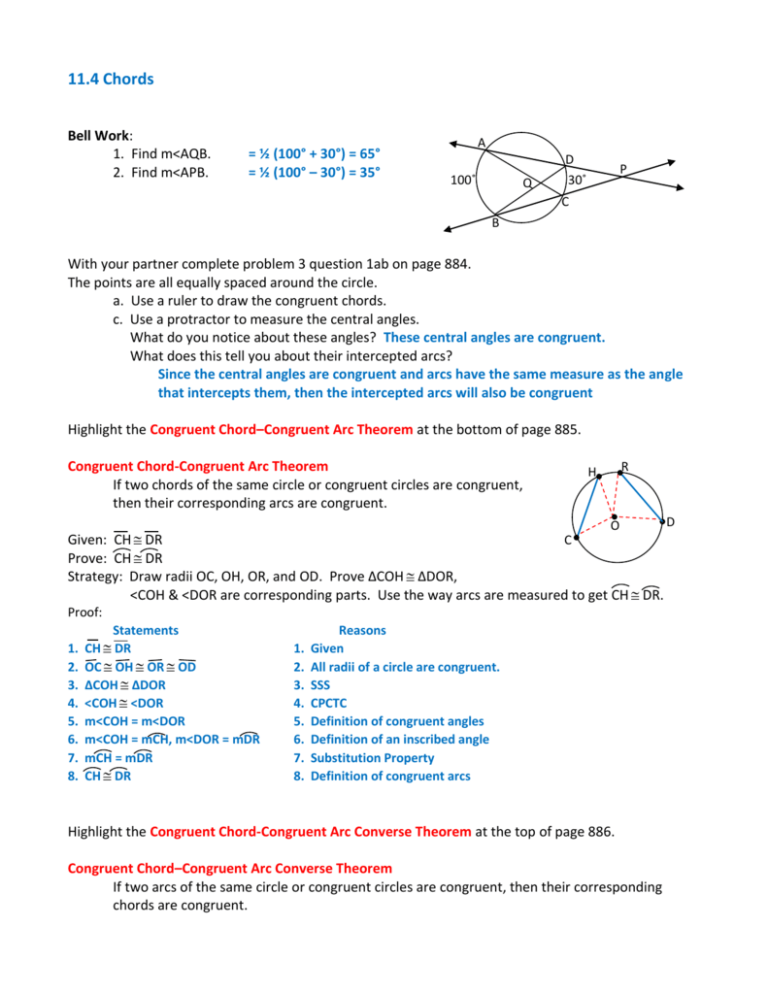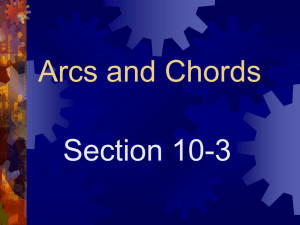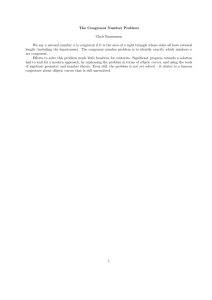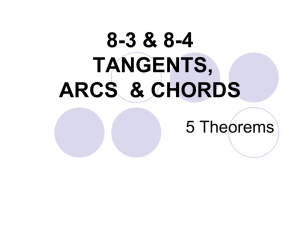11.4 Chords
advertisement

11.4 Chords Bell Work: 1. Find m<AQB. 2. Find m<APB. = ½ (100° + 30°) = 65° = ½ (100° – 30°) = 35° A 100˚ Q D 30˚ P C B With your partner complete problem 3 question 1ab on page 884. The points are all equally spaced around the circle. a. Use a ruler to draw the congruent chords. c. Use a protractor to measure the central angles. What do you notice about these angles? These central angles are congruent. What does this tell you about their intercepted arcs? Since the central angles are congruent and arcs have the same measure as the angle that intercepts them, then the intercepted arcs will also be congruent Highlight the Congruent Chord–Congruent Arc Theorem at the bottom of page 885. Congruent Chord-Congruent Arc Theorem If two chords of the same circle or congruent circles are congruent, then their corresponding arcs are congruent. R H O C Given: CH DR Prove: CH DR Strategy: Draw radii OC, OH, OR, and OD. Prove ΔCOH ΔDOR, <COH & <DOR are corresponding parts. Use the way arcs are measured to get CH DR. Proof: 1. 2. 3. 4. 5. 6. 7. 8. Statements CH DR OC OH OR OD ΔCOH ΔDOR <COH <DOR m<COH = m<DOR m<COH = mCH, m<DOR = mDR mCH = mDR CH DR 1. 2. 3. 4. 5. 6. 7. 8. Reasons Given All radii of a circle are congruent. SSS CPCTC Definition of congruent angles Definition of an inscribed angle Substitution Property Definition of congruent arcs Highlight the Congruent Chord-Congruent Arc Converse Theorem at the top of page 886. Congruent Chord–Congruent Arc Converse Theorem If two arcs of the same circle or congruent circles are congruent, then their corresponding chords are congruent. D Given: CH DR Prove: CH DR This proof is almost identical to the above proof so we will not do it. Any time both a theorem and its converse are true, the two of them can be put into one theorem by using a form called a bi-conditional. Formula: p if and only if q. With your partner complete problem 3 question 4 on page 886. Two chords of the same circle or congruent circles are congruent, if and only it, their corresponding arcs are congruent. Read problem 1 on page 878 and complete question 1abcdefg with the class. 1b. Use a ruler to find the midpoint of YR. Use a protractor to draw the perpendicular at the midpoint. 1d. Use a ruler to find the midpoint of BR. Use a protractor to draw the perpendicular B at the midpoint. 1f. Use a ruler to find the midpoint of BY. Use a protractor to draw the perpendicular at the midpoint. 1g. How are these 3 perpendicular bisectors related? They all pass through the center of the circle. Thus each of these perpendicular bisectors contain diameters of the circle. Y C Diameter–Chord Biconditional Theorem A circle’s diameter is perpendicular to a chord, if and only if, the diameter bisects the chord and bisects the arc determined by the chord. Given: Circle O w/diameter MI, MI | DA Prove: MI bisects DA, MI bisects DA Strategy: Draw radii OD and OA. Prove ΔODE ΔOAE. Then DE & AE and <DOI &<AOI are corresponding parts. Given: Circle O w/ MI | bisect DA and/or MI | bisector DA Prove: MI is a diameter Complete the proof of the forward part of this theorem with the class using the space provided at the top of page 879. R D O M I E A Statements 1. MI | DA 2. <OED and <OEA are rt. <’s 3. ΔOED and ΔOEA are rt. Δ’s 4. OD OA 5. OE OE 6. ΔOED ΔOEA 7. DE AE 8. MI bisects AD 9. <DOI <AOI 10. DI AI 11. MI bisects DA Reasons 1. Given 2. Definition of perpendicular 3. Definition of right triangle 4. All radii of a circle are congruent. 5. Reflexive Property 6. HL 7. CPCTC 8. Definition of segment bisector 9. CPCTC 10. Congruent Chords-Congruent Arcs Theorem 11. Definition of arc bisector With your partner complete problem 1 question 3ab on page 880. Use a ruler to draw two chords that are the same length. (congruent) For example: HC = 2 cm and RD = 2 cm a. Use a ruler to locate the midpoint. C Use a protractor to draw the perpendicular at this point. b. Use a ruler instead of a compass to measure the lengths. For example: O to midpt CH = 0.5 cm and O to midpt RD = 0.5 cm The distances are the same. Equidistant Chord Biconditional Theorem Two chords of the same circle or congruent circles are congruent, if and only if, they are equidistant from the center of the circle. Given: CH DR, OE | CH, OI | RD Prove: OE OI Given: OE OI, OE | CH, OI | RD Prove: CH DR We will not prove this biconditional theorem. This biconditional theorem has many applications. 1. Carpenters use it to construct circular openings in buildings and arches. 2. Archeologists use it to restore pottery found at digs. Homework: Skills Practice Problem Set 11.4 prob. 2 – 4, 8 – 10, 14 – 16, 20 – 22. R H D O R H I E O C D







